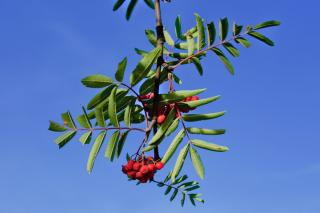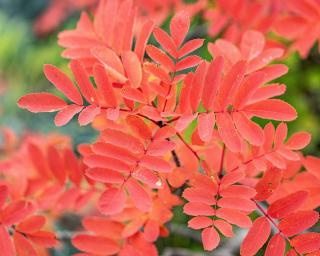

Mountain ash (rowan in British English) is an elegant shrubby tree that both bees and birds adore. Spring blooming is full of nectar and turn into nutritious red berries by Fall for birds.
Key Sorbus facts
Name – Sorbus aucuparia
Family – Rosaceae
Type – tree
Height – 16 to 50 feet (5 to 15 meters)
Exposure – full sun
Soil – rich and deep, not very chalky
Foliage – deciduous
Flowering – May-June
Fruit formation – June to October
A very easy tree to care for, it’s perfect for wild hedges along large fields, shrub beds, and even occasionally as a standalone.
 Favor planting in Fall to make it easier for the plant to spread its roots and properly resume growth in Spring. For plants purchased in pots or containers, you can plant in other seasons than fall as long as both freezing and dry spells are avoided.
Favor planting in Fall to make it easier for the plant to spread its roots and properly resume growth in Spring. For plants purchased in pots or containers, you can plant in other seasons than fall as long as both freezing and dry spells are avoided.
Sorbus has quite a long lifespan, reaching to over 120 years old.
No pruning mandatory, but if you wish to reduce or reshape the shrub, wait for the blooming to end. Winter is also a good time (at the end of the season).
However, what’s very important is never to prune between March 15th and July 31st. In many countries, the law forbids it with good reason, since this is when wild birds are nesting.
<!–silent
–>
A common name for this tree is “bird ash tree”. Our feathered friends favor it for the many red-orange berries that hand to the tree even as leaves have fallen away in Autumn. Excellent to attract birds to your garden. They’ll thank you with a chorus of birdsong all summer long!
In Spring, you’ll also find the tree buzzing with activity. It’s one of the main suppliers of nectar for insects and honeybees. Helping the environment out on all accounts!
 Rowan mountain ash used to be planted along fields to attract thrushes in Autumn for hunting. Fruits, or rowanberries, are edible even when raw, though they taste too rough and tart, not a very pleasing experience. They’re excellent when baked into jam and jelly.
Rowan mountain ash used to be planted along fields to attract thrushes in Autumn for hunting. Fruits, or rowanberries, are edible even when raw, though they taste too rough and tart, not a very pleasing experience. They’re excellent when baked into jam and jelly.
You would harvest the berries in Fall. There are many varieties of rowan tree, most bear red berries, but there are a few ornamental yellow-fruited ones, too. Birds, however, love them all!
So whether raw or cooked, mountain ash berries are edible. Nonetheless, it’s strongly recommended to only nibble on a few at a time. When ingested raw in greater quantities, a slightly toxic side-effect appears which is due to parasorbic acid (literally “the acid of the Sorbus tree”), a compound present in the berries. Cooking produces heat that breaks this particular parasorbic acid down, so it disappears. This makes it possible to cook jelly, jam, and even spirits or alcohol from the fruits of these mountain ash berries.
Boost flower and fruit formation easily by removing dead wood from the center of the tree. Branches often die naturally as months flow by, and cutting them off frees space for light and sun to enter.